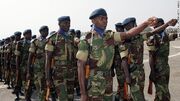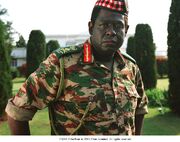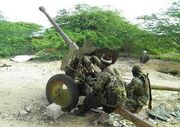
The "Chokwe Revolutionary Army".

Chokweland (grey) right after gaining independence.

Chokwe soldiers during the war against Zambia.

Rebel forces after their defeat.

Negao Jasso in 1934.

The Chokwe army during the Chokwe-Ovambo War.

Ovambo soldiers ruing the Chokwe-Ovambo War.

Chokwe artillery during the Chokwe-Ovambo War.

Ovambo resistance fighter.

Chokweland after the Chokwe-Ovambo War.

Burundi resistance fighter.

Chokwe Tanks invading Burundi.

Chokweland after the invasion of Burundi.

Negao Jasso in 1937.

Chokweland after the 1938 purchase.

Chokwe fighter.

Chokwe bomber during the war in Burundi.

Chokwe Artillery in Burundi.

Chokwe artillery in the Burundi War.
Negao Jasso (15 August 1881 - 9 September 1940) was a Chokwe Dictator. He is considered the founding father of the Chokwe Nation and managed to make Chokweland one of the strongest states in Sub-Saharan Africa. He was born in 15 August 1881 in Kalabo. His father, Adolph Jasso, was the Village Chief of Kalabo who had converted to Christianity and studied in Brazil, hence his Latin name. At that time, Chokweland was under Brazilian control.
Negao Jasso quickly mastered the Spanish writing, a prequisite for any serious chance of studying in a Brazilian university, while honing his colloquial Chokwe writing. In addition to his studious endeavors, he was fond of adventure, and loved to fly kites and go fishing.
In 1899, Negao Jasso was enrolled in the Brazilian University of History and Archaeology in Chokweland. Negao Jasso was involved in an anti-tax demonstration of poor peasants in 1901, which endangered his student status. He graduated from the University in 1903 with a Master in Ancient History. In 1906, he took a job as a history teacher at a school in Kalabo.
In 1915–16 he organized "Youth Education Classes" and occasionally gave nationalist lectures to young Chokwe people. Negao Jasso organized the "Chokwe Revolutionary Army" in 1920, mostly made up of poor peasants and Chokwe nationalists, and started an irregular war against Brazilian forces.
In 1926, thanks to a massive revolt by the Ovambo tribe and other Chokwe nationalistic groups, Brazilian rule collapsed. The Brazilians were typically overwhelmed and destroyed, and the local garrison were devastated and slaughtered relentlessly.
In 1927, most of Chokweland came under Negao Jasso's control, as his military forces destroyed all other Chokwe military groups. In 1928, Negao Jasso organized elections and, by rigging the votes, he won by 97%. He then used his military forces to arrest more than 20,000 who opposed his rule, 13,000 of which were late killed.
In 1930, the Burundi nation, having been raiding throughout the region to support the fledgling nation's tenuous economic system, faced a war with southern Zambia. The Zambians retaliated for these raids by using their limited military force to drive north and defeat the nuisance of the raiding. There was a substantial feint attack to the west which worked perfectly, diverting the capacity of Burundi's defense in the wrong direction. The feint turned into a bloody engagement, but left the door open for an assault upon Kalemie itself. The Zambian army managed to take the Burundi capital and outflank their forces, which have withdrew further into the interior. Negao Jasso condemned this move, fearing the growing Zambian power, and mobilized troops to the border, threatening an escalation of the conflict if a peace was not made.
However, the Zambians refused to retreat from Burundi. Calling for the restoration of the prewar status quo and the independence of Burundi, the Chokwe prepared themselves to lead a fresh offensive against Zambian forces in 1931. The initial Zambian attack proved mostly successful, pushing towards the Lualaba River, and driving the Burundian armies back. Eventually, they were halted, as Chokwe forces were brought to bear, using planes and heavy artillery to completely disorient and destroy the Zambian forces. The counteroffensive quickly annihilated the remaining Zambian forces in the north, and the Chokwe and Burundian forces drove east, retaking Kalemie from Zambia. Thanks to superior weapons, air support, and overall better military forces, the Chokwe proved a far greater opponent than the Burundians the Zambians had been fighting. Fresh Chokwe forces were mobilized along the border, while Negao Jasso appealed for the Zambians to make peace before more drastic action was taken.
In 1932, the Treaty of Luau was signed by all three belligerent nations and established a proper border between Burundi and Zambia. With the new border agreed upon, all three countries also agreed to a ten year nonaggression pact to prevent further outbreaks of violence, agreeing to the other standing borders. This brought an uneasy peace to southeastern Africa for the first time in years. Negao Jasso used this military victory to further consolidate his control of Chokweland, but opposition groups still remained active, despite further purges and executions.
The government of Negao Jasso faced its first real threat in 1933 as a cabal of opposition leaders in the military sought to gain power for themselves. The plot was geared towards overthrowing the right wing Jasso regime and replacing it with one allegedly for the people. The generals responsible, unfortunately, did not keep their plans quite enough and Jasso was able to detect the plot and prepare his loyalists. Though most rebellious units were isolated before they could cause trouble, the loyal forces prepared a trap for those that remained. The dissenting forces attempted to march into Luau but were cut off and quickly surrounded by the armies of Jasso. The resulting battle was more of a slaughter, as a number of the rebel commanders did escape with what was left of their forces or were killed themselves in the fighting. Jasso claimed that the parties responsible for the attack were influenced by treacherous groups within the Proletarist regime of the Ovambo, and pledged that this act of aggression would not go unnoticed. Negao Jasso, having crushed the revolt, started the "Great Purge" in which more than 30,000 people were arrested and mass murdered.
Negao Jasso proclaimed in 1934, now in total control of Chokweland, that the Ovambos’ proletarist government threatened the peace and stability of the region, and the well-being of the people. He declared the regime of Syndic Amadi Beloyi to be illegitimate and forfeit, pledging to establish a much more stable and righteous system for the Ovambo people. The Empire of Brazil offered their own support to the Chokwe cause, initiating a blockade off the coast of Ovamboland, preventing the arrival of further supplies from other proletarist states. The Syndic pledged to fight to the last, and prepared military forces to respond to the attack, which began quickly and effectively. Despite some minor initial gains by the Chokwe forces, the offensive stalled against determined resistance, as supply lines were sabotaged and the Ovambo fought bitterly. The Chokwe continued their advances, but with heavy casualties.
The war between the Chokwe and Ovambo was not very popular on the home front, despite the encouragement for the offensive from foreign powers. In 1935, the unpopularity of the war was demonstrated with a revolt among the new ranks of Chokwe conscripts recruited for waging the war and invasion. When ordered to march to the war in the south, these conscripts chose instead to riot, killing their officers and threatening to bring chaos to the area surrounding the base. Loyal military forces were quickly sent in to restore order, but found the riot too large to immediately handle. The base was cordoned off, and more military forces were diverted from the front lines, including aircraft and heavy equipment. With the deployment of artillery and tanks, the revolt was suppressed, but casualties proved heavy on both sides of the impromptu battle.
Finally, in the end of 1935, the brutal two year war between the Ovambo and Chokwe came to an end, with the complete defeat of the proletarist government and their armies. The proletarists of the Ovambo were incapable of matching the same size and scale of the Chokwe armies, and had been forced to surrender with the collapse of the front lines. The collapse came early in the year after the larger Chokwe force launched a frenzy attack upon all points along the border.
The attacks broke through in numerous places, and within a few years, the Chokwe forces were entering Velamanville, and ending local rule. Syndic Amadi Beloyi and his cohorts mostly fled to Scandinavia, leaving only a token group of leaders to surrender to their enemies. Nehale Nelumbo, a military leader who had been captured earlier by the Chokwe, was been put in charge of the Ovambo nation. He stated that he would prevent the succumbing of the nation to proletarist wiles and deceit once more. The new treaty between the two also ceded the northern provinces to the Chokwe, granting them a larger territory and control, looming over the southern state. Lastly, the new treaty allowed Chokwe goods to go through on Ovambo infrastructure with no tariffs, inspections, or taxation, being protected by Chokwe soldiers.
In early 1936, Negao Jasso signed the Treaty of Luau with Botswana:
1.The nations of Chokweland and Botswana will agree to a defensive alliance in which they will defend each other.
2.Chokweland agrees to protect the Government of Botswana from revolutions or coups.
3.Botswana agrees to eliminate the tariffs and taxation of Chokwe goods in Botswana.
After his defeat of the Ovambo, Negao Jasso turned upon his closest regional ally, Burundi. Having spared Burundi from destruction during a war with Zambia, Chokweland claimed that Burundi had repaid this kindness by continuing raids into Chokwe territory. In response, they declared war in 1936 and launched a full scale invasion along the border, using planes in full support of their advancing forces. Burundi, outgunned and outnumbered, still managed to put up a considerable fight, dealing far more damage than would have been expected in their situation. The vicious battles cost the Chokwe a heavy toll, essentially causing them to lose over half of their army in the fighting from mounting casualties. Despite some successes, Burundi was doomed, as no help was forthcoming from any of the nation’s neighbors. Burundi was officially annexed, and Negao Jasso proclaimed all former residents of the nation to now be citizens of Chokweland.
The Prime Minister of Kongo responded to this Chokwe expansionism by stating "We are quite concerned at your recent aggressive actions. Further untoward expansion and aggression towards your neighbors will be met with an appropriate response from us, and our allies". Negao Jasso was forced to agree not to expand anymore.
In 1937, Chokwe military forces begun taking steps to rebuilding and reclaiming control of Burundi after last year’s successful operation against the raider state. The army was looking to track down the remnants of the government and army of former Burundian leader Imamu Bapela, who remained at large after the fall of Kalemie. Bapela and his forces were able to elude the Chokwe and continued to raid and strike at Chokwe supporting towns and outposts.
They inflicted significant damages to the invading army, all while avoiding capture or defeat on the battlefield. While the fighting was going underway, the Chokwe government begun focusing on reconstruction, rebuilding the minor damages that had been done to the region’s infrastructure during the invasion. The continuing unrest and guerrilla warfare made the process difficult, as has the lack of any skilled engineers or personnel within the Chokwe regime. Negao Jasso promised to keep up the fight against the illegal Bapela government and to restore order and stability to Burundi under Chokwe rule.
In 1938, a new territorial agreement was made between the leadership of Chokweland and its satellite state in Ovamboland. In exchange for a pittance amount of finances, the Chokwe pushed the border a bit further south, securing a corridor to the Atlantic Ocean. This corridor passes through the Namib Desert and possesses essentially no territory of any value, beyond access to the sea. Some foreign critics of the purchase called the new territory Jasso’s Folly, simply because due to the nature of the sand seas and the year around thick fog off the coast, it was said to be by far the worst possible place in the world for a new port as proposed by the Chokwe government. Regardless, the purchase went forward, and the Ovambo successfully managed to make the only profit that will ever likely be accrued thanks to the Namib Desert by the sale to the Chokwe.
The armies and military forces of the Chokwe leadership continued and in 1939 to struggle to find the former ruler of the Burundi nation, Imamu Bapela. He and his growing guerilla force continued to wage a guerilla war against the Chokwe regime throughout both Burundi and Chokweland. Due to the size of the nation and the small amount of forces available to the Chokwe, Bapela easily evaded the best efforts to corral his troops, striking at numerous targets throughout the country.
Operations began to build new bases and roads came under attack constantly, delaying the program and often destroying the resources dedicated to it. Dense jungles and forests allowed the forces of Bapela to constantly evade airborne reconnaissance, which was proven worthless in most respects. The army he had mustered always appeared in greater strength than the Chokwe had at any given point either overwhelming them or withdrawing before air support could be called. Casualties mounted, even among the Chokwe civilian population as Bapela continued to raid villages and towns as the Chokwe armies struggled to search for his bases.
The armies of Chokweland at last managed to corner and eliminate general Bapela in 1940, waging a unceasing campaign of hunting. The general was killed in battle against the Chokwe, who claimed the body was cremated following his death. The general’s forces were disbanded and scattered, though some scattered raiding parties and militias remained as a legacy.
The instability caused by the marauder continued to remain, as the Chokwe struggled to maintain a lid upon growing tribal rivalries and unrest within the nation’s borders. However, the largest armed threat to the central government had been suppressed, and officials within government claimed this as a turning point in the nation’s history. Negao Jasso died in 9 September 1940, aged 59. The reason of his death was stomach cancer. Negao Jasso is considered the founding father of Chokweland, as he created the Chokwe state and expanded it to it's current borders.
